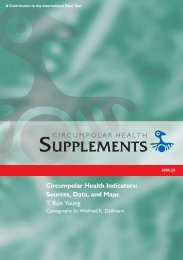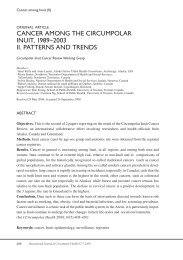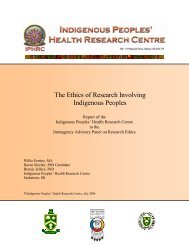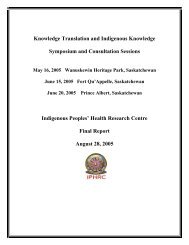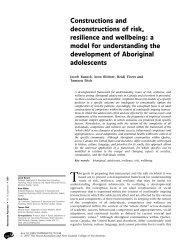EVALUATION OF THE ONTARIO COMMON ASSESSMENT ... - CCIM
EVALUATION OF THE ONTARIO COMMON ASSESSMENT ... - CCIM
EVALUATION OF THE ONTARIO COMMON ASSESSMENT ... - CCIM
Create successful ePaper yourself
Turn your PDF publications into a flip-book with our unique Google optimized e-Paper software.
OCAN Evaluation for Aboriginal Mental Health Programs<br />
therefore normally helps the client fill out the consumer self assessment form. This can take quite some time,<br />
ranging from 30 minutes to about 2 hours.<br />
Clients and providers agreed that the coding is very difficult and confusing for clients, since codes such as “No<br />
Need”, “Met Need” and “Unmet Need” are very abstract concepts and do not directly answer the questions<br />
posed in the tool.<br />
When staff have to complete the OCAN over the phone these challenges are often compounded. Since the<br />
need for services is much greater than available resources, staff are often reluctant to spend an additional<br />
session on the OCAN, knowing that they have only few sessions with their clients in a given year.<br />
Fit of the automated OCAN tool<br />
Clients are generally accepting of the idea of having their information recorded in electronic format and<br />
potentially shared with other providers. Still, there are some trust issue related to the electronic record for<br />
some clients. At times, there is a need to keep paper records only, to ensure that the information is accessible<br />
only to one worker. This is an important issue due to the many family relationships in small communities, where<br />
electronic records might become inadvertently accessible to family members in the future who work in the<br />
system in the future. As on provider explained : “every one is related to everyone around here”. Consequently<br />
some mental health services clients are reluctant to be linked into a server at the hospital.<br />
Electronic medical records are currently being introduced within the health system at the James Bay Coast the<br />
system is ready for electronic records, although providers reported that there are currently frequent glitches<br />
to access electronic records.<br />
In order for clients to enter their own information, a computer dedicated to OCAN is seen as necessary,<br />
however even then providers believe direct entry is not feasible since they frequently have to rephrase the<br />
questions for clients in the self assessment tool to make them more appropriate for this population.<br />
Fit of OCAN with Aboriginal client population and presenting concerns<br />
The providers generally felt that a weakness of the tool is that it is too prescriptive in some areas without<br />
covering other areas adequately which are seen as essential in this client population. One provider stated: “it<br />
feels like you are putting the client into a box as you are fitting them into the categories of the OCAN” and<br />
there is resistance to do this from both providers and clients. Another criticism was that OCAN “doesn’t feel<br />
holistic [when used with a client] , although it is presented as a holistic tool”.<br />
Providers felt that OCAN is most useful for clients with SMI who are stable. There was agreement that it was<br />
difficult to use with clients with the following presenting concerns:<br />
• intergenerational trauma, including residential school trauma<br />
• people in crisis<br />
• clients who see workers “just to unload” because they have problems and no one to talk to<br />
• brief intervention with clients, who will potentially not be seen again for a year(s)<br />
• grief issues and complex issues<br />
Sutherland & Maar - March 2010 Page 25



